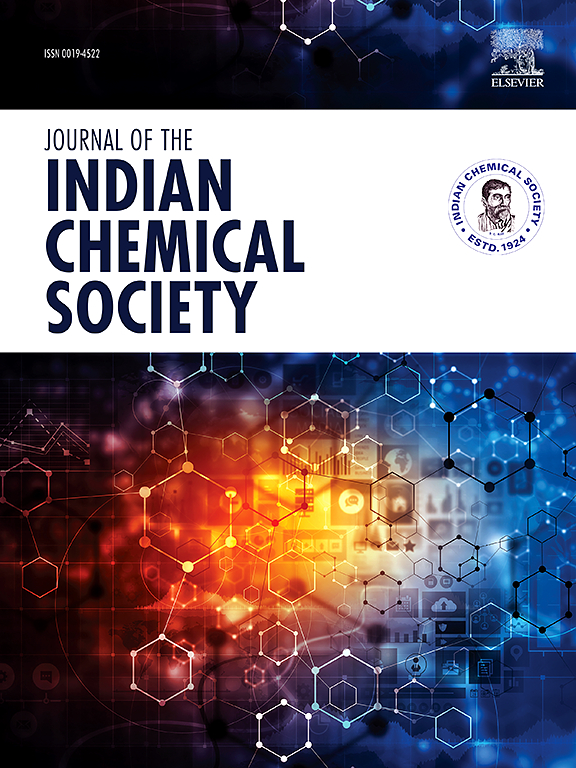微波辅助酶合成丙酸香茅烯基在非水介质:优化,在硅的见解,和动力学分析
IF 3.2
4区 化学
Q2 CHEMISTRY, MULTIDISCIPLINARY
引用次数: 0
摘要
香茅烯丙酸酯是一种萜烯酯,广泛用作香精香料原料。在微波照射下,利用具有相同极性支持的不同脂酶,将亲核试剂β-香茅醛(β-citronello)与不同的酰基供体进行酯交换反应,成功合成了β-香茅醛。对各种反应参数进行了优化、比较和筛选,以获得最佳转化率和产率。对不同的有机溶剂进行了比较,得到了最佳的催化活性。CALB (Candida antarctica lipase B)-Immobead 150a脂肪酶活性最高,在丙酸乙烯酯的所有反应中转化率和选择性均高达99%。优化后的反应条件为:CALB-Immobead负载150 A 0.26% w/v,正庚烷溶剂,实验室反应器搅拌速度400 rpm,香茅醛与丙酸乙烯酯的等摩尔比,温度70℃。分子对接表明CALB对丙酸乙烯酯的特异性高于TL脂肪酶。微波辐照进一步提高了初始反应速率。微波辐照的Arrhenius频率因子(A)由于局部加热增强和非热效应等多重因素的影响,比常规加热的Arrhenius频率因子(A)高1.6倍。为了确定本征动力学,研究了克服传质阻力和颗粒内扩散限制的最佳反应体系。发现该反应受酶动力学限制。本文拟合并验证了乒乓球比划非序列模型。因此,提出了一种新颖的,可扩展的,可持续的实验室规模的工艺,优于所有以前报道的香茅酰丙酸合成。本文章由计算机程序翻译,如有差异,请以英文原文为准。

Microwave-assisted enzymatic synthesis of citronellyl propionate in non-aqueous media: optimization, in-silico insights, and kinetic analysis
Citronellyl propionate, a terpene ester, is widely used as a flavour and fragrance material. In this work, it was successfully synthesized under microwave irradiation via transesterification of β-citronellol (as nucleophile) with different acyl donors using dissimilar lipases with the same apolar support. Various reaction parameters were optimized, compared and screened for an optimum conversion and yield. Different organic solvents were compared to get the best catalytic activity. CALB (Candida antarctica lipase B)-Immobead 150 A lipase showed the highest activity among those studied, with up to 99 % conversion and selectivity in all reactions of vinyl propionate. The optimized reaction consisted of conditions: CALB-Immobead 150 A 0.26 % w/v loading, heptane solvent, 400 rpm agitation speed in a lab reactor, an equimolar ratio of citronellol and vinyl propionate, and 70 °C. Molecular docking indicated that CALB has more specificity for vinyl propionate than TL lipase. The initial reaction rate was further intensified by microwave irradiation. The Arrhenius frequency factor (A) of microwave irradiation was 1.6 fold more than that of conventional heating due to multiple factors like enhanced localized heating and non-thermal effects. To determine intrinsic kinetics, the optimum reaction system was studied to overcome mass transfer resistance and intra-particle diffusion limitations. It was found that the reaction is enzyme kinetic limited. A ping pong bi-bi non-sequential model was fitted and validated. Thus, a novel, scalable, and sustainable lab-scale process is presented that outperformed all previously reported citronellyl propionate syntheses.
求助全文
通过发布文献求助,成功后即可免费获取论文全文。
去求助
来源期刊
CiteScore
3.50
自引率
7.70%
发文量
492
审稿时长
3-8 weeks
期刊介绍:
The Journal of the Indian Chemical Society publishes original, fundamental, theorical, experimental research work of highest quality in all areas of chemistry, biochemistry, medicinal chemistry, electrochemistry, agrochemistry, chemical engineering and technology, food chemistry, environmental chemistry, etc.

 求助内容:
求助内容: 应助结果提醒方式:
应助结果提醒方式:


